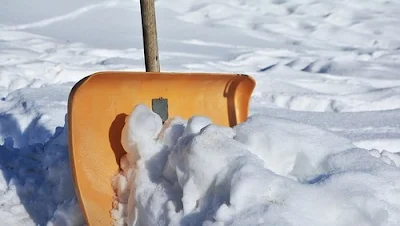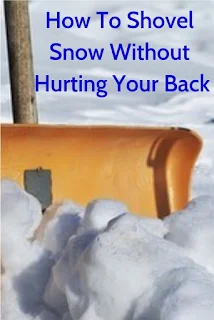One of the main causes of back pain and back injury is doing something as simple as shoveling snow the wrong way. The same people that would never think of lifting weights go outside and shovel snow without a second thought. Yet in reality, they are lifting heavy weights. And one wrong move is all it takes to really injure your back.
Shoveling snow can be both an aerobic exercise and weight lifting at the same time. The constant motion is the equivalent of walking on a treadmill or riding an exercise bike, and the lifting of the heavy wet snow is every bit the equal of lifting heavy weights. You must be very careful to not injure your back.
How Much Weight is the Snow Are You Shoveling
Light fluffy snow might weigh as little as 5 pounds per cubic foot. Compacted snow can weigh 20 pounds per cubic foot and heavy wet snow can weigh even more and feel like you are shoveling wet cement. The amount of water can be stated as a percentage. According to the National Snow and Ice Data center, the average snow in the US is between .04 and .10 percent of water per inch. T
he fluffy powder snow is between .01 and .05 while the heavy wet snows can be .40 and higher. You can calculate how much weight you lift shoveling snow.
If you have a double car driveway, it can be 800 square feet (40’ x 20’). The weight of a cubic foot of water is 62.418 pounds. You have to convert inches to feet. So 6” = .5 of a foot (6/12 = .5). We will use 10% (.10) amount of water in this snowfall.
Cubic feet of snow = square foot of driveway (800) x the amount of snow (.5 of a foot) = 400 cubic feet of snow.
Multiply the amount of water in the snow (.10) x 62.418 = 6.242 pounds of snow per cubic feet of snow.
Multiply the weight of this cubic foot of snow (6.242) by the cubic feet of snow you will be shoveling (400 cubic feet). 6.242 x 400 = 2,947 pounds
You are lifting almost 3,000 pounds of snow when you shovel the driveway. Not only lifting but also turning to throw it to the side.
Proper Ways to Shovel Snow
When you shovel, keep your back straight and bend your knees. Your knees should be shoulder width apart. Bend at the knees and straighten your knees when you lift.
Lift with the legs and not your back. It is best if you don’t twist and throw the snow, if possible try and place the snow where you want it or throw it forward. Space your hands apart; this will give you better leverage lifting the snow.
Twisting while holding the weight of the snow can hurt your back. If you want to throw the snow, don’t load up the snow shovel with a ton of snow. Take smaller scoops of snow. Take breaks and catch your breath occasionally. If you feel any kind of pain, stop shoveling.
The Proper Snow Shovel
A lightweight shovel will weigh less than an old metal one, and the snow is already heavy enough. The shovel should be about chest high. If the shovel is too short, you end up bending too much. If the shovel is too long, that causes the snow to actually weigh more and the lifting that much harder, not only hurting your back, but also your wrist and forearms.
If you’re going to buy a new shovel, look for one that has a bent staff or ergonomic type. The bent staff type of snow shovel prevents back pain and strain by allowing you to bend less while shoveling. Most people say that this type of shovel prevents the soreness in their backs after shoveling snow.
Wet snow sticking to the scoop increases the weight and frustration level every time you try to shake it off and can also hurt your wrists. For an older shovel, you can try car wax, ski wax, floor wax or silicon spray on the scoop to prevent the snow from sticking.
Others spray the shovel with PAM or WD40. A good blade also helps you to get the packed snow instead of having to chop with the shovel, which further stresses the back.
Helpful Hints when Shoveling Snow
Shoveling snow is not easy work, and emergency rooms are always busier during and after a snowstorm as people dig out. Most emergency calls are related to back injuries, sprains, and broken bones due to falling on the ice, plus heart attacks and frostbite.
About the Author
Sam Montana is a certified Food Over Medicine instructor from the Wellness Forum Health Center and certified in optimal nutrition from the Harvard T.H. Chan School of Public Health.
Copyright © 2009-2019 Sam Montana

